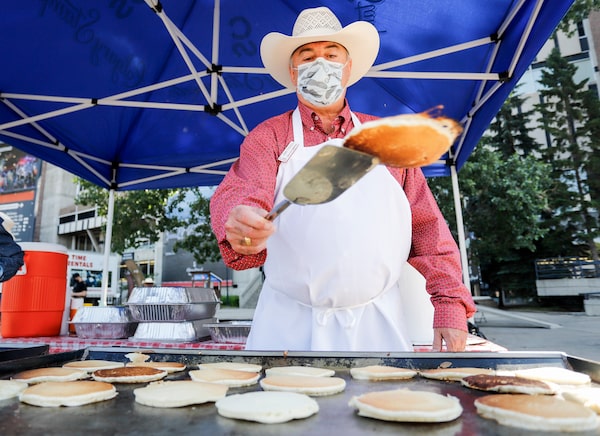A woman takes a photo of her family on Family Day as the Calgary Stampede gets underway in Calgary, Alberta, on July 9, 2021.TODD KOROL/Reuters
Alberta is known for its wide expanses, and at the Calgary Stampede this year open spaces are everywhere. On the exhibition grounds, aisles surrounding the rides and food stands have been extended; in the grandstand, seating is at a reduced capacity. And despite the free pass giveaways, no one is sure how big the crowds will be – or whether there will even be big crowds.
Alberta is the first Canadian province to lift nearly all public health restrictions related to the pandemic, and the province’s most famous spectacle is on after being cancelled in 2020. But the Calgary Stampede – by far the largest event in the country since the start of COVID-19 early last year – will be a far more muted affair than in years past.
Public-facing Stampede staff are masked, the number of famous free pancake breakfasts has been reduced, and the city’s hotels, restaurants and bars report only a small percentage of the usual out-of-province and international visitors they’d see this time of year. Many downtown corporate events are off or being held with fewer people. Some Albertans who might consider going to the exhibition grounds or evening show are waiting to see how the first few days pan out.
Plans for Calgary Stampede include reduced attendance, COVID-19 safety protocols
Meanwhile, back at the ranch, the rural Alberta roots of Calgary Stampede culture live on
But coronavirus cases in the province are low, and on Friday Alberta Health Services reported zero new daily COVID-19 deaths. And despite the public health debate about whether it’s premature for the annual 10-day celebration of Old West culture to go ahead, some people are happy to be out at a big event for the first time in months.
“I do sort of feel nervous. But I’m keeping positive,” said Shaneel Nandan, 20, who reunited with a group of friends early Friday morning so they could be among the first to enter the Stampede grounds.
“This whole year was cramped up in our houses. We’re just trying to make the best summer.”

A father and his daughter enjoy a ride at the Calgary Stampede.Jeff McIntosh/The Canadian Press
The Stampede midway starts up for Family Day at the Stampede.TODD KOROL/Reuters

John Tyrrell flips pancakes outside the grandstand on the Stampede grounds.Jeff McIntosh/The Canadian Press
The opening parade went ahead on Friday, with the usual high production values, floats, miniature horses and marching bands. But the procession was still one of the COVID-19 era – it didn’t go through downtown Calgary as it would in normal years, and instead just wound through the Stampede grounds. And it was a broadcast-only experience. The politicians on horseback waved at the cameras instead of onlookers. The crack of a cowboy’s stockwhip echoed on the mostly empty pavement.
There are also changes at the Elbow River Camp, where local First Nation families have long offered traditional storytelling and ceremonies, and sold art and food from the Bannock Booth. The families are now broken into two cohorts, the teepees number 19 instead of the usual 26, and even outdoor events are scaled back.
It’s not only COVID-19 that is altering Stampede proceedings at the camp, however. This is also a period when the country is paying new attention to the history of residential schools, after the discovery of undocumented or unmarked graves in western Canada.

First Nations elders ride during the Calgary Stampede parade.Jeff McIntosh/The Canadian Press

Calgary Stampede parade marshal Katari Right Hand leads the parade.Jeff McIntosh/The Canadian Press
There will be a moment of silence every morning to honour the Indigenous children who suffered and died in the schools, and camp flags will be at half-mast every day of the Stampede, said Lowa Beebe, a spokeswoman and volunteer at the Elbow River Camp.
Members of Treaty 7 families who have come to the Stampede year after year since its beginning in 1912 were also were forced to attend the schools, she said.
“This is definitely opening old wounds.”
She added: “We know our history – it’s Canada that’s learning. There have been some people that understood residential schools but they understand it more now. And they understand the impact was actually bigger than they originally thought.”
A Stampede worker sanitizes seats before the start of the rodeo.TODD KOROL/Reuters
A man gets a COVID-19 test before being allowed entry into Nashville North a live concert venue.TODD KOROL/Reuters
Other changes on the general grounds include sanitation stations everywhere. Food trucks make up a bigger proportion of the concessions, and there’s now a digital queue for major attractions such as the Dog Bowl.
At Nashville North, the usually packed and rambunctious live-music hub, anyone wanting to enter the 3,500-person venue is required to provide proof of vaccination or take a rapid COVID-19 test. The enclosed tent has been replaced with an open-air canvas.
The daily rodeo is still a go but the evening Rangeland Derby chuckwagon races are postponed to 2022. Grant Doyle, a long-time promoter of Western events, said many of the stars of the rodeo world aren’t here this year, either.
“I’m happy the Stampede is going ahead. But I wish it would have been in September. I wish it would have involved wagons,” Mr. Doyle said.
“However, I’ve seen that people need something to get more comfortable again. I think the Stampede will prove to be a positive, not a negative.”

Visitors walk onto the Stampede grounds.Jeff McIntosh/The Canadian Press
We have a weekly Western Canada newsletter written by our B.C. and Alberta bureau chiefs, providing a comprehensive package of the news you need to know about the region and its place in the issues facing Canada. Sign up today.
 Kelly Cryderman
Kelly Cryderman